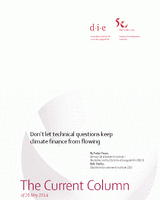Don’t let technical questions keep climate finance from flowing
Pauw, Pieter / Adis DzeboThe Current Column (2014)
Bonn: German Development Institute / Deutsches Institut für Entwicklungspolitik (DIE) (The Current Column of 26 May 2014)
Bonn, Stockholm, 26 May 2014. 2014 is another crucial year for climate finance. It will be an important subject at the climate summit that UN General Secretary Ban Ki Moon will host in September 2014, and last week the Board of the ‘Green Climate Fund’ pushed through the still outstanding decisions to make the fund operational by the end of the year. Huge uncertainties remain about how to account for climate finance from the private sector – but that should not keep us from involving the private sector more.
At the 2010 UN Climate Summit in Cancun, developed countries pledged to mobilize $100 billion (bn) USD in climate finance per year from 2020 onwards. The private sector was included as one of the sources of this USD 100 bn. As 2020 comes closer, the international debate on climate finance is increasingly focusing on these private sector contributions. Developing countries are rightfully concerned that this focus on private contributions delays and reduces the flow of already constrained public contributions for action on the ground. Yet leveraging private finance is crucial for global adaptation and mitigation initiatives – including in developing countries. We just cannot let the “$100 bn question” get in the way.
All kinds of technical questions need to be answered when identifying ways to mobilize private investments that contribute to the $100 bn USD. The climate finance discussion thus moved towards highly complex issues like tracking, scaling-up and replication of private climate investments. Paradoxically, this effort could delay action on mobilizing private-sector finance.
Increasing efforts are being made to quantify and track private climate finance flows. For example, the Organisation for Economic Co-operation and Development (OECD) and others are analysing tracking methods and ways to measure publicly mobilized private climate finance. The assessment has, to date, mainly focused on project finance in climate change mitigation and is severely compromised by a lack of data. The renewable energy sector might be an exception, but comprehensive financial data on mitigation through energy efficiency, transportation, agriculture and forestry currently do not exist. The situation is even more complicated for adaptation finance.
In addition, there are problems with respect to attribution, additionality and the definitions of “private” and “climate finance”. Through attribution, double counting should be prevented: when several actors are involved, the investment should not be ‘attributed’ to all of them in entirety. Additionality in the context of private-sector finance means proving that without Country X efforts, private investments in, say solar power in Country Y, would not have been made. Proving this can be very difficult, especially if causes and effects are indirect. Lastly, a lack of agreed definitions of “private sector” and “climate finance” creates information gaps and different interpretations from different actors.
All these issues combined lead to inaccuracies and ambiguities, and make it difficult to determine how much climate finance actually flows. This, in turn, leaves developing countries puzzled and distrustful – both about climate finance flows in the years leading up to 2020 and about whether the $100 bn target will be met.
Another important question that the Climate Change Expert Group of the OECD currently addresses is how to replicate and scale-up climate interventions. Successful examples of public-private interventions were found in both mitigation and adaptation, but the latter appears to be more challenging. The analysis shows that advantageous private engagement can be stimulated when public finance and public policies are effectively used, for example, through suitable regulatory frameworks and institutional arrangements, building technical capacity, and risk mitigation mechanisms. Public financing can also be used to close the information gaps.
It is important to keep working to resolve all the issues and exploit the opportunities mentioned above. Along the way, trust must be build between developed and developing countries, most notably with regard to tracking and assigning responsibilities and verifying whether investments have real impacts on the ground. However, it must be acknowledged that some issues will either never be solved or always be contentious.
The Intergovernmental Panel on Climate Change’s Fifth Assessment Report recently highlighted the urgent need for larger investments in mitigation –the door to prevent dangerous climate change is closing – and in adaptation, as climate change impacts are already noticeable throughout the world. The lack of resolution on the private-sector related issues above should not keep climate finance from flowing. The ultimate goal is not to meet the $100 bn target, but to move towards low-carbon and climate-resilient societies.
Pieter Pauw, Department “Environmental Policy and Natural Resources Management”, German Development Institute / Deutsches Institut für Entwicklungspolitik (DIE)
Adis Dzebo, Research Associate, Stockholm Environment Institute (SEI)
